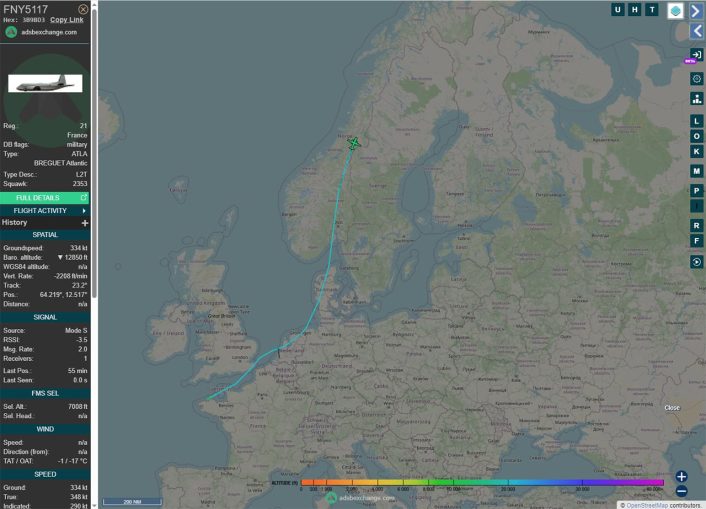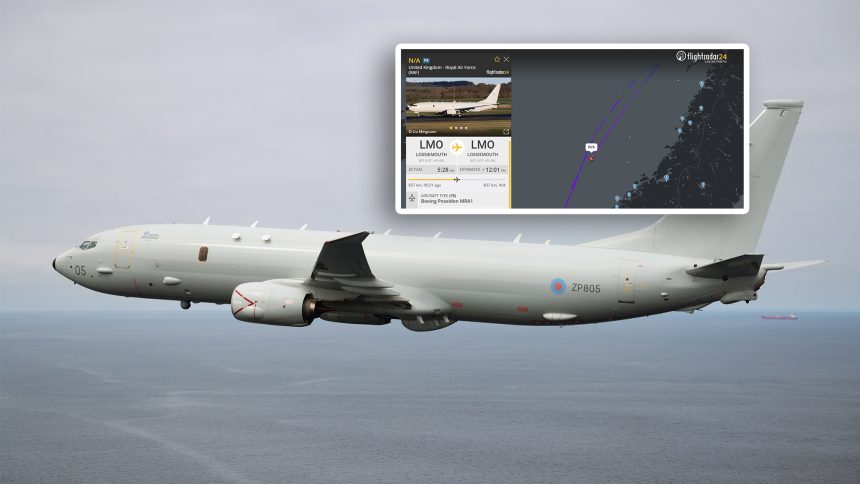U.S, UK, and Norwegian forces have mounted a significant anti-submarine operation in the Norwegian Sea using maritime patrol aircraft to track suspected Russian submarine activity.
After aviation enthusiasts this week noted an intense flow of Royal Air Force P-8 Poseidon MRA1s back and forth from RAF Lossiemouth, British and Norwegian media outlets are now reporting that NATO forces have been hunting what they believe to be a Russian submarine, or perhaps submarines, since at least Sunday, Aug. 24, 2025. With the U.S. Navy’s newest and largest aircraft carrier, the USS Gerald R. Ford, currently operating in the region, it would be a prime opportunity for Russia’s submarine force to gather intelligence on or cause a nuisance for NATO forces.
Launching long range patrols from their home base in Scotland, the RAF’s P-8s have been visible via flight tracking websites like Flightradar24. They have been tracked heading north, along the coast of Norway, appearing to then begin operations at a lower altitude northwest of Narvik. Each aircraft is relieved as it turns to head home, allowing persistent 24/7 coverage. Notably, these missions began several days before the date media reports suggest the search began, although prior flights may have been more precautionary in nature – to screen and sanitize areas for the carrier group to operate in.
RAF P-8 activity over 24 hours.
5 aircraft been used to keep one on station over the Norwegian Sea. (We need more than 9 P-8s) pic.twitter.com/cVR0iJ5Vh3
— Britsky (@TBrit90) August 25, 2025
U.S. Poseidons have also joined the party, operating from Keflavik, Iceland. At least half a dozen U.S. P-8s are currently stationed at the Icelandic forward operating base, with additional aircraft redeployed from elsewhere in Europe to bolster the force for ongoing operations. Norwegian P-8s have also been noted taking part, though fewer are visible on flight tracking websites in comparison – likely due to a mix of data coverage and transponder mode usage. Their base at Evenes Air Station, near Narvik, has also been utilised by U.S. aircraft for temporary deployments and refueling stops.
On Aug. 27 a French Navy Breguet Atlantique 2 was tracked on ADS-B Exchange travelling from France to northern Norway, indicating that, assuming they hadn’t already done so, France is now joining the ongoing mission.

At present, the USS Gerald R. Ford carrier strike group (CSG) is known to be operating quite far to the south of the anti-submarine warfare (ASW) patrol area. Supply flights using C-2A Greyhounds can be tracked heading to and from the carrier from ashore. Additionally, on Aug. 22, two F/A-18 Super Hornets diverted from the Ford to RAF Lossiemouth. One aircraft, suffering from a technical issue involving its landing gear, remained at the British base until Aug. 26 when it took off and safely returned to the carrier.
US Navy Carrier Strike Group 12 is somewhere in the North Atlantic today, between Bergen, Norway and Shetland.
Unless they fool us with ADS-b =) Even so, close to that spot. pic.twitter.com/1LkSdCXHhA
— auonsson (@auonsson) August 25, 2025
2nd visit of the day for the @USNavy C2 to @RAFLossiemouth followed by a beautiful looking E2 🤯😍🇺🇲🇺🇲 #avgeek #military #planespotting #aviationlovers #aviation #USNAVY #USNavyPhotosoftheDay pic.twitter.com/mRlRrzErof
— stevo howells (@Stevo_SnakeDR) August 25, 2025
While there is significant physical distance between the suspected submarine and the carrier group, the ever-increasing effective range of both weaponry and intelligence gathering technology means the area of ‘interest’ around a carrier group can extend many hundreds of miles. It may also be the case that the tentative plans for the carrier group could include heading further north into the area where Russian submarine activity is suspected, creating a requirement for any such threat to the carrier to be located, identified, and, if possible, corralled away.
Complementing the aforementioned land-based aircraft, there are likely to be surface and sub-surface assets involved in the search. These are, naturally, much more difficult to trace as observers than airborne units as they can operate for weeks, or even months, at a time without making port. Additionally, the Norwegian Sea is already a common operating location for NATO warships so deployments of such units there would not be out of the ordinary.
Official comment is rarely made regarding NATO submarine operations, but we are at least able to see when and where they enter or leave port. HMS Anson is presently the only Royal Navy submarine at sea, having departed HMNB Clyde at Faslane on Aug. 19. It is more difficult to tell which U.S. submarines may be active in the region, though we do know that the Virginia class submarine USS New Mexico recently visited Faslane, departing on Aug. 25. While, again, it’s far from certain, it is very likely that more U.S. subs are operational around the Greenland-Iceland-UK gap as well as further north.
USS New Mexico (SSN 779) Virginia-class Block II attack submarine leaving Faslane, Scotland – August 25, 2025
SRC: TW-@MichaelJWC626 pic.twitter.com/yP9g1lFgu2
— WarshipCam (@WarshipCam) August 25, 2025
The recent departure of a new Yasen class submarine for the Russian Navy on sea trials means there is likely a U.S. submarine presence in the Barents Sea keeping tabs on the new sub and attempting to capture its unique audio signature to assist in future identification and classification purposes. The Yasen class is Russia’s newest nuclear-powered cruise missile submarine (SSGN) and will be on the receiving end of any new technologies developed by Russia to keep their submarines as stealthy as possible, making them an intelligence boon for NATO forces.
Numerous reports of heightened Russian submarine activity have surfaced in recent weeks, notably following an announcement by U.S. President Donald Trump that two U.S. nuclear submarines were being moved to “appropriate regions” in response to what he called inflammatory statements by the former Russian Prime Minister Dmitry Medvedev, who serves as Deputy Chairman of the Security Council of Russia. Open source analysis suggests that an Akula class attack submarine (SSN) and a Yasen class SSGN might be the culprits lurking below the surface off Norway.
1/2
Since it’s in the wind:
Suspect we have had (at least?) two Northern Fleet subs on patrol in the Greenland- / Norwegian Sea / down to GIUK area since late July and that these now have been tracking north for a while.
Best bet is an Akula-class SSN and a Yasen-class SSGN.
— Thord Are Iversen (@The_Lookout_N) August 27, 2025
Routine Activity
While some outlets present news about this operation with a dramatic, sensationalist flair, it is important to remember that similar cat-and-mouse games have been played between NATO and Russia for many decades. A lull after the end of the Cold War shattered in 2014 with Russia’s invasion of Crimea, deteriorating year upon year until the absolute breaking point in 2022 with the full-scale invasion of Ukraine. We know that during the Cold War, both sides would regularly hunt the others’ submarines with extreme prejudice, coming within feet of each other, colliding on more than one occasion. Surface and air units would pummel suspected submarines with depth charges, though no submarines are known to have actually been destroyed by this tactic.
Much like the consistent probes of NATO air defenses by Russian Air Force and Russian Navy aircraft, though much more stealthy, submarines are one of the most effective and common tools to use to harass the opposing side. However, as they are also much more secretive in their operations, we as civilians will often not hear about any of their escapades until years, even decades, after the fact. Only when incidents end up involving other, more public, assets might their operations be revealed in some way – for example, when a Russian submarine was suspected of fouling the towed array of Royal Navy Type 23 frigate HMS Northumberland in late 2020.
‘Harassing’ your foe may sound like superfluous and dangerous behavior – in some cases, it can be – but within it lies a strong military strategy. By presenting your force at close quarters, you draw your opposition out to mirror you, leaving you able to gather data on response times and type, as well as on any weapons or sensor systems in use. This can be particularly effective during exercises where you gain not only intelligence value, but also disrupt your opponent’s training regimens.









